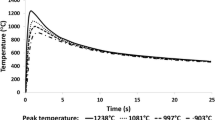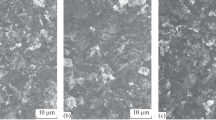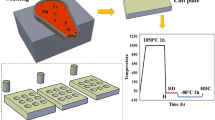Abstract
Although the damage development in the railway steels is relatively well documented in the scientific literature, its appearance in railway crossings remains a quite complicated issue because of the extreme loading conditions during the train passage. The exact local conditions cannot be determined with sufficient accuracy, but the steel microstructure contains the traces of the mechanisms of microstructure and damage evolution. In this work, we discuss the microstructural evolution and damage in a field-loaded railway crossing made of cast austenitic Hadfield steel and subjected to impact and rolling contact fatigue (RCF) loading. A nanoscale twinning substructure surrounded by dislocation cells and a high dislocation density are identified using Electron Channeling Contrast Imaging (ECCI) and Transmission Electron Microscopy (TEM) in the deformed microstructure of Hadfield steels. The effect of these substructures as well as of the non-metallic inclusions and other casting defects on the damage development in the austenitic Hadfield steels is also discussed. Additionally, the strain-induced transformation of the austenite into martensite in the deformed crossing surface is studied by X-ray diffraction and magnetometer measurements. The results do not show evidence of strain-induced austenite-to-martensite transformation under impact and RCF loading of the railway crossings. ECCI in controlled diffraction conditions is used to study the fatigue crack growth in undeformed cast Hadfield steel specimens when subjected to laboratory scale fatigue testing. Furthermore, the role of twins and grain boundaries on the fatigue crack growth is discussed.
Access this chapter
Tax calculation will be finalised at checkout
Purchases are for personal use only
Similar content being viewed by others
References
Adler PH, Olson GB, Owen WS (1986) Strain hardening of Hadfield manganese steel. Metall Mater Trans A 17:1725–1737
Yan W, Fang L, Sun K, Xu Y (2007) Effect of surface work hardening on wear behavior of Hadfield steel. Mater Sci Eng A 460:542–549
Srivastava AK, Das K (2008) Microstructural characterization of Hadfield austenitic manganese steel. J Mater Sci 43:5654–5658
Lv B, Zhang M, Zhang FC, Zheng CL, Feng XY, Qian LH, Qin XB (2012) Micro-mechanism of rolling contact fatigue in Hadfield steel crossing. Int J Fatigue 44:273–278
Harzallah R, Mouftiez A, Felder E, Hariri S, Maujean J-P (2010) Rolling contact fatigue of Hadfield steel X120Mn12. Wear 269:647–654. https://doi.org/10.1016/J.WEAR.2010.07.001
Kumar A, Makineni SK, Dutta A, Goulas C, Steenbergen M, Petrov RH, Sietsma J (2019) Design of high-strength and damage-resistant carbide-free fine bainitic steels for railway crossing applications. Mater Sci Eng A 759:210–223. https://doi.org/10.1016/J.MSEA.2019.05.043
Garnham JE, Davis CL (2008) The role of deformed rail microstructure on rolling contact fatigue initiation. Wear 265:1363–1372. https://doi.org/10.1016/J.WEAR.2008.02.042
Singh A, Dao M, Lu L, Suresh S (2011) Deformation, structural changes and damage evolution in nanotwinned copper under repeated frictional contact sliding. Acta Mater 59:7311–7324. https://doi.org/10.1016/J.ACTAMAT.2011.08.014
Morris WL (1980) The noncontinuum crack tip deformation behavior of surface microcracks. Metall Trans A 11:1117–1123. https://doi.org/10.1007/BF02668135
King A, Ludwig W, Herbig M, Buffière JY, Khan AA, Stevens N, Marrow TJ (2011) Three-dimensional in situ observations of short fatigue crack growth in magnesium. Acta Mater 59:6761–6771. https://doi.org/10.1016/J.ACTAMAT.2011.07.034
Güngör S, Edwards L (1993) Effect of surface texture on the initiation and propagation of small fatigue cracks in a forged 6082 aluminium alloy. Mater Sci Eng A 160:17–24. https://doi.org/10.1016/0921-5093(93)90493-X
Herbig M, King A, Reischig P, Proudhon H, Lauridsen EM, Marrow J, Buffière JY, Ludwig W (2011) 3-D growth of a short fatigue crack within a polycrystalline microstructure studied using combined diffraction and phase-contrast X-ray tomography. Acta Mater 59:590–601. https://doi.org/10.1016/J.ACTAMAT.2010.09.063
Suresh S (1983) Crack deflection: implications for the growth of long and short fatigue cracks. Metall Trans A 14:2375–2385. https://doi.org/10.1007/BF02663313
Navarro A, De Los Rios ER (1992) Fatigue crack growth modelling by successive blocking of dislocations. Proc R Soc A Math Phys Eng Sci 437:375–390. https://doi.org/10.1098/rspa.1992.0067
Liu L, Wang J, Gong SK, Mao SX (2014) Atomistic observation of a crack tip approaching coherent twin boundaries. Sci Rep 4:4397
Sinha T, Kulkarni Y (2014) Alternating brittle and ductile response of coherent twin boundaries in nanotwinned metals. J Appl Phys 116:183505
Xiao JH, Zhang FC, Qian LH (2013) Contact stress and residual stress in the nose rail of a high manganese steel crossing due to wheel contact loading. Fatigue Fract Eng Mater Struct 37:219–226. https://doi.org/10.1111/ffe.12108
Yan W, Fang L, Zheng Z, Sun K, Xu Y (2009) Effect of surface nanocrystallization on abrasive wear properties in Hadfield steel. Tribol Int 42:634–641
Kang J, Zhang FC, Long XY, Lv B (2014) Cyclic deformation and fatigue behaviors of Hadfield manganese steel. Mater Sci Eng A 591:59–68. https://doi.org/10.1016/J.MSEA.2013.10.072
Wei-yong W, Bing L, Venkatesh K (2013) Effect of temperature on strength and elastic modulus of high-strength steel. J Mater Civ Eng 25:174–182. https://doi.org/10.1061/(ASCE)MT.1943-5533.0000600
Qian L, Feng X, Zhang F (2011) Deformed microstructure and hardness of Hadfield high manganese steel. Mater Trans 52:1623–1628
Zhao L, van Dijk N, Brück E, Sietsma J, van der Zwaag S (2001) Magnetic and X-ray diffraction measurements for the determination of retained austenite in TRIP steels. Mater Sci Eng A 313:145–152. https://doi.org/10.1016/S0921-5093(01)00965-0
Van Tol RT (2014) Microstructure evolution in deformed austenitic Twinning Induced Plasticity steels, Delft University of Technology. https://doi.org/10.4233/uuid:b2a057e2-c545-4bcc-854c-fe4b9344e486
Zaefferer S, Elhami N-N (2014) Theory and application of electron channelling contrast imaging under controlled diffraction conditions. Acta Mater 75:20–50. https://doi.org/10.1016/J.ACTAMAT.2014.04.018
Gutierrez-Urrutia I, Raabe D (2012) Grain size effect on strain hardening in twinning-induced plasticity steels. Scr Mater 66:992–996. https://doi.org/10.1016/J.SCRIPTAMAT.2012.01.037
Gutierrez-Urrutia I, Zaefferer S, Raabe D (2010) The effect of grain size and grain orientation on deformation twinning in a Fe–22 wt.% Mn–0.6 wt.% C TWIP steel. Mater Sci Eng A 527:3552–3560. https://doi.org/10.1016/j.msea.2010.02.041
Gutierrez-Urrutia I, Zaefferer S, Raabe D (2009) Electron channeling contrast imaging of twins and dislocations in twinning-induced plasticity steels under controlled diffraction conditions in a scanning electron microscope. Scr Mater 61:737–740. https://doi.org/10.1016/J.SCRIPTAMAT.2009.06.018
Gutierrez-Urrutia I, Zaefferer S, Raabe D (2013) Coupling of electron channeling with EBSD: toward the quantitative characterization of deformation structures in the sem. JOM 65:1229–1236. https://doi.org/10.1007/s11837-013-0678-0
Kumar A, Agarwal G, Petrov R, Goto S, Sietsma J, Herbig M (2019) Microstructural evolution of white and brown etching layers in pearlitic rail steels. Acta Mater. https://doi.org/10.1016/J.ACTAMAT.2019.04.012
Makineni SK, Kumar A, Lenz M, Kontis P, Meiners T, Zenk C, Zaefferer S, Eggeler G, Neumeier S, Spiecker E, Raabe D, Gault B (2018) On the diffusive phase transformation mechanism assisted by extended dislocations during creep of a single crystal CoNi-based superalloy. Acta Mater 155. https://doi.org/10.1016/j.actamat.2018.05.074
Bay B, Hansen N, Hughes DA, Kuhlmann-Wilsdorf D (1992) Overview no. 96 evolution of f.c.c. deformation structures in polyslip. Acta Metall Mater 40: 205–219. https://doi.org/10.1016/0956-7151(92)90296-q
Hansen N, Jensen DJ (1997) Development of microstructure in FCC metals during cold work. Philos Trans R Soc London A Math Phys Eng Sci 357:1447–1469
Beladi H, Timokhina IB, Estrin Y, Kim J, De Cooman BC, Kim SK (2011) Orientation dependence of twinning and strain hardening behaviour of a high manganese twinning induced plasticity steel with polycrystalline structure. Acta Mater 59:7787–7799. https://doi.org/10.1016/J.ACTAMAT.2011.08.031
Steinmetz DR, Jäpel T, Wietbrock B, Eisenlohr P, Gutierrez-Urrutia I, Saeed-Akbari A, Hickel T, Roters F, Raabe D (2013) Revealing the strain-hardening behavior of twinning-induced plasticity steels: theory, simulations, experiments. Acta Mater 61:494–510. https://doi.org/10.1016/J.ACTAMAT.2012.09.064
Agarwal G, Kumar A, Gao H, Amirthalingam M, Moon SC, Dippenaar RJ, Richardson IM, Hermans MJM (2018) Study of solidification cracking in a transformation-induced plasticity-aided steel. Metall Mater Trans A Phys Metall Mater Sci. https://doi.org/10.1007/s11661-018-4505-7
Agarwal G, Kumar A, Richardson IM, Hermans MJM (2019) Evaluation of solidification cracking susceptibility during laser welding in advanced high strength automotive steels. Mater Des 183:108104. https://doi.org/10.1016/j.matdes.2019.108104
Sun D, Garimella SV (2007) Numerical and experimental investigation of solidification shrinkage. Numer Heat Transf Part A Appl 52:145–162. https://doi.org/10.1080/10407780601115079
Hardin RA, Beckermann C (2013) Effect of porosity on deformation, damage, and fracture of cast steel. Metall Mater Trans A 44:5316–5332. https://doi.org/10.1007/s11661-013-1669-z
Peters NW, Eng P (2005) The performance of Hadfield’s manganese steel as it relates to manufacture, Dostupné Na Internetu. Accessed May 11, 2015. http://www.arema.org/files/library/2005_Conference_Proceedings/00040.pdf
Grabulov A, Petrov R, Zandbergen HW (2010) EBSD investigation of the crack initiation and TEM/FIB analyses of the microstructural changes around the cracks formed under Rolling Contact Fatigue (RCF). Int J Fatigue 32:576–583. https://doi.org/10.1016/J.IJFATIGUE.2009.07.002
Kumar A, Dutta A, Makineni SK, Herbig M, Petrov RH, Sietsma J (2019) In-situ observation of strain partitioning and damage development in continuously cooled carbide-free bainitic steels using micro digital image correlation. Mater Sci Eng A 757:107–116. https://doi.org/10.1016/J.MSEA.2019.04.098
Collette G, Crussard C, Kohn A, Plateau J, Pomey G, Weisz M (1957) Contribution à l’étude des transformations des austénites à 12% Mn. Rev Met Paris 54:433–486. https://doi.org/10.1051/metal/195754060433
Spreadborough J (2018) Stacking faults in iron–manganese and cobalt–nickel. Acta Crystallogr 13:603–605. https://doi.org/10.1107/S0365110X60001448
Olson GB, Cohen M (1972) A mechanism for the strain-induced nucleation of martensitic transformations. J Less Common Met 28:107–118
Pickering EJ (2013) Macrosegregation in steel ingots: the applicability of modelling and characterisation techniques. ISIJ Int 53:935–949
Takahashi J, Kawakami K, Ueda M (2010) Atom probe tomography analysis of the white etching layer in a rail track surface. Acta Mater 58:3602–3612. https://doi.org/10.1016/J.ACTAMAT.2010.02.030
Mazancová E, Mazanec K (2009) Stacking fault energy in high manganese alloys. Mater Eng 16:26–31
Pierce DT, Jiménez JA, Bentley J, Raabe D, Wittig JE (2015) The influence of stacking fault energy on the microstructural and strain-hardening evolution of Fe–Mn–Al–Si steels during tensile deformation. Acta Mater 100:178–190. https://doi.org/10.1016/J.ACTAMAT.2015.08.030
Jost N, Schmidt I (1986) Friction-induced martensitic transformation in austenitic manganese steels. Wear 111:377–389. https://doi.org/10.1016/0043-1648(86)90134-1
Pineau AG, Pelloux RM (1974) Influence of strain-induced martensitic transformations on fatigue crack growth rates in stainless steels. Metall Trans 5:1103–1112. https://doi.org/10.1007/BF02644322
Baudry G, Pineau A (1977) Influence of strain-induced martensitic transformation on the low-cycle fatigue behavior of a stainless steel. Mater Sci Eng 28:229–242. https://doi.org/10.1016/0025-5416(77)90176-8
Das A, Tarafder S (2009) Experimental investigation on martensitic transformation and fracture morphologies of austenitic stainless steel. Int J Plast 25:2222–2247. https://doi.org/10.1016/J.IJPLAS.2009.03.003
Pippan R, Hohenwarter A (2016) The importance of fracture toughness in ultrafine and nanocrystalline bulk materials. Mater Res Lett 4:127–136
Suresh S, Ritchie RO (1984) Propagation of short fatigue cracks. Int Met Rev 29:445–475. https://doi.org/10.1179/imtr.1984.29.1.445
Kumar A, Saxena AK, Kirchlechner C, Herbig M, Brinkmann S, Petrov RH, Sietsma J (2019) In situ study on fracture behaviour of white etching layers formed on rails. Acta Mater. https://doi.org/10.1016/J.ACTAMAT.2019.08.060
Goulas C, Kumar A, Mecozzi MG, Castro-Cerda FM, Herbig M, Petrov RH, Sietsma J (2019) Atomic-scale investigations of isothermally formed bainite microstructures in 51CrV4 spring steel. Mater Charact. https://doi.org/10.1016/j.matchar.2019.03.038
Chen YQ, Pan SP, Zhou MZ, Yi DQ, Xu DZ, Xu YF (2013) Effects of inclusions, grain boundaries and grain orientations on the fatigue crack initiation and propagation behavior of 2524-T3 Al alloy. Mater Sci Eng A 580:150–158. https://doi.org/10.1016/J.MSEA.2013.05.053
Zhai T, Wilkinson AJ, Martin JW (2000) A crystallographic mechanism for fatigue crack propagation through grain boundaries. Acta Mater 48:4917–4927. https://doi.org/10.1016/S1359-6454(00)00214-7
Taylor D, Knott JF (1981) Fatigue crack propagation behaviour of short cracks; the effect of microstructure. Fatigue Fract Eng Mater Struct 4:147–155
Saxena AK, Kumar A, Brinckmann S, Herbig M, Dehm G, Kirchlechner C (2019) Micro fracture investigations of white etching layers. Mater Des 180:107892. https://doi.org/10.1016/j.matdes.2019.107892
Acknowledgements
This research was carried out under project number F91.10.12475b in the framework of the Partnership Program of the Materials innovation institute M2i (www.m2i.nl) and the Foundation for Fundamental Research on Matter (FOM) (www.fom.nl), which is part of the Netherlands Organisation for Scientific Research (www.nwo.nl). Authors would like to thank Dr. Michael Herbig, Max-Planck-Institut für Eisenforschung GmbH, for providing necessary experimental facilities for this research. We would like to thank ProRail for its financial support and arranging the specimens for this research.
Author information
Authors and Affiliations
Corresponding author
Editor information
Editors and Affiliations
Rights and permissions
Copyright information
© 2021 Springer Nature Switzerland AG
About this chapter
Cite this chapter
Kumar, A., Petrov, R., Sietsma, J. (2021). Damage and Microstructure Evolution in Cast Hadfield Steels Used in Railway Crossings. In: Galeazzi, R., Kjartansson Danielsen, H., Kjær Ersbøll, B., Juul Jensen, D., Santos, I. (eds) Intelligent Quality Assessment of Railway Switches and Crossings. Springer Series in Reliability Engineering. Springer, Cham. https://doi.org/10.1007/978-3-030-62472-9_4
Download citation
DOI: https://doi.org/10.1007/978-3-030-62472-9_4
Published:
Publisher Name: Springer, Cham
Print ISBN: 978-3-030-62471-2
Online ISBN: 978-3-030-62472-9
eBook Packages: EngineeringEngineering (R0)




